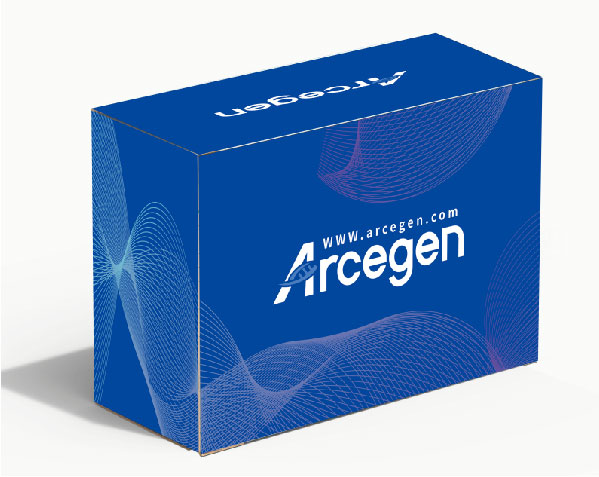Mouse TNF-α ELISA Kit
Product description
Tumor necrosis factor-alpha (TNF-α), also known as cachexin or TNFSF1A, is a multifunctional cytokine that plays a central role in inflammation, apoptosis, and immune system development. It is produced by various immune cells, epithelial cells, endothelial cells, and tumor cells. TNF-α exerts its effects through receptors TNFR1 and TNFR2, activating signaling pathways involving caspase 8, transcription factor NF-κB, and kinase JNK.
Human TNF-α shares 79% amino acid homology with mouse TNF-α, suggesting that its biological functions may not exhibit significant species specificity. TNF-α has been shown to confer resistance against certain types of infections while paradoxically inducing inflammation in pathological processes. It may also affect glucose uptake and insulin resistance. Additionally, TNF-α plays a critical role in tumor proliferation, migration, invasion, and angiogenesis.
The Arcegen Mouse TNF-α ELISA assay kit is an in vitro enzyme-linked immunosorbent assay (ELISA) kit designed to quantitatively measure mouse TNF-α in serum and plasma samples. The assay utilizes high-affinity anti-mouse TNF-α antibodies pre-coated onto an ELISA plate. Standard samples and test samples are added to the plate wells and incubated, allowing mouse TNF-α present in the samples to bind to the solid-phase antibodies. After washing to remove unbound substances, a detection antibody is added for incubation, followed by addition of enzyme conjugate (Streptavidin-HRP). After washing again, a colorimetric substrate (TMB) is added for color development, and the intensity of the color reaction is proportional to the concentration of mouse TNF-α in the samples. The reaction is terminated, and absorbance is measured at 450 nm wavelength (with a reference wavelength of 570-630 nm).
Specifications
|
Item Number |
P162006S / P162006E |
|
Specification |
48 T / 96 T |
|
Detection Range |
31.25-2000 pg/mL |
|
Detection Method |
Sandwich ELISA |
|
Species Detected |
Mouse |
|
Detection Time |
4.5 hours |
|
Sensitivity |
7.82 pg/mL |
|
Dilution Linearity |
84 - 124% |
|
Recovery Rate |
81 - 119% |
|
Intra-assay Variability |
3.8% |
|
Inter-assay Variability |
5.3% |
Components
|
Component Number |
Component Names
|
Storage Temperature |
P162006S |
P162006E |
|
P162006-A |
ELISA plate |
2~8℃ |
48 T |
96 T |
|
P162006-B |
Standard sample |
2~8℃ |
1 tube |
2 tubes |
|
P162006-C |
Detection antibody |
2~8℃ |
120 μL |
240 μL |
|
P162006-D |
Enzyme conjugate |
2~8℃(Avoid Light) |
30 μL |
60 μL |
|
P162006-E |
5× dilution buffer |
2~8℃ |
8 mL |
15 mL |
|
P162006-F |
20× wash buffer |
2~8℃ |
25 mL |
50 mL |
|
P162006-G |
Substrate solution |
2~8℃(Avoid Light) |
8 mL |
15 mL |
|
P162006-H |
Stop solution |
Room Temperature |
5 mL |
10 mL |
|
P162006-I |
Plate sealing film |
Room Temperature |
3 pieces |
5 pieces |
Storage
The kit can be stored at 2~8°C, or according to the storage conditions of individual components to avoid contamination and repeated freeze-thaw cycles. Diluted reagents prepared to working concentration should be used immediately and discarded; they should not be reused. The shelf life is 1 year.
Table 1. Reagent Storage Table After Initial Use
|
Component Names |
Storage Conditions |
|
ELISA plate |
Unused strips can be returned to the aluminum foil bag, tightly sealed, and stored at 2~8°C to avoid moisture absorption. |
|
Standard sample |
Use within 48 hours after dissolution, store at 2~8°C to avoid contamination. |
|
Detection antibody |
Use within 48 hours after dilution, store at 2~8°C to avoid contamination. |
|
Enzyme conjugate |
|
|
5× dilution buffer |
Store at 2~8°C for 1 month, avoiding contamination.
|
|
20× wash buffer |
|
|
Substrate solution |
Store at 2~8°C for 1 month, avoiding light exposure. |
|
Stop solution |
Can be stored at room temperature. |
|
Plate sealing film |
Catalog No.:*
Name*
phone Number:*
Lot:*
Email*
Country:*
Company/Institute:*

